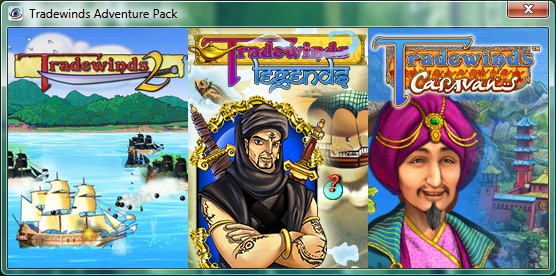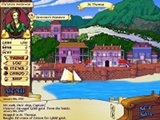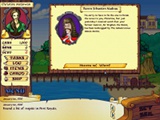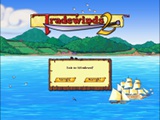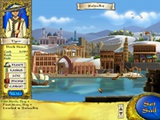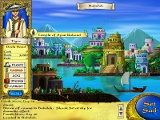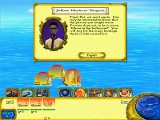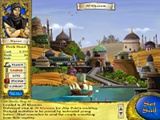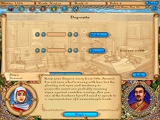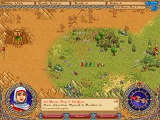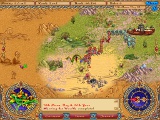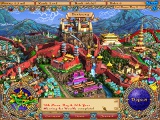





Luxor Bundle 3-in-1: (demo)
Luxor 2
Luxor 3
Luxor: Quest for the afterlife
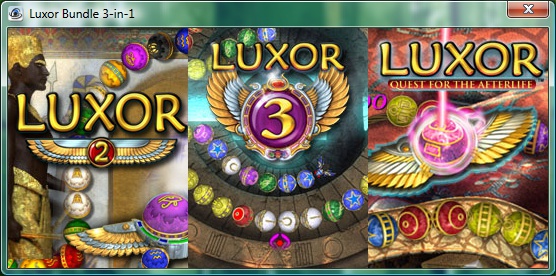
I was a bit wary of the Luxor 2 Acer GameZone demo because of the spartan, unappealing Luxor Classic marble shooter included with Luxor Adventures. This version, however, is glossy and colourful, with much better backgrounds, and rows of marbles that don't roll through a channel, but snake over paths that have to be guessed. These backgrounds are reused for each batch of levels; once I'd finished all levels starting with "1", level 2-1 started against the same background as level 1-1, although the name and, supposedly, purpose of this level was different.
This game has the same Egyptian winged paddle to shoot marbles as Luxor Classic, and ends the level in the same way, with a creature (scorpion? bug?) whizzing through the marbles' empty path and dislodging gems and other valuables that I'm supposed to catch with the paddle. But it's fast! The string of marbles gets a headstart on me, rolling out before a marble appears on the paddle to shoot with. There are three play modes, Adventure (advancing through levels), Survival (choose one level and have new chains appear continually until you're beaten) and Practice (choose a level that has been unlocked by finishing that level successfully in Adventure mode). Additionally, there are three game settings: Easy, Normal, and Expert. I thought the chain was fast in Easy, and have no idea what it's like in Expert. There is a gallery of "badges" for special gameplay achievements.
The improved graphics extend to the cute little beetle pushing the marbles, which is also the game icon image. When the last marbles are destroyed, the beetle explodes in a rain of gems and rings which have to be caught for extra points. At the end of the level, the player also has to catch ankh coins. Destroying marbles before the level's end drops the odd special effect: slow down, roll backward, colour cloud, focus, and some others.
All three games are made by MumboJumbo, so I shouldn't be surprised that the background music, which has a sense of urgency to it, is interspersed with cat screechings and jackal howls, the latter reminding me of the evening neighbourhood sounds in The Sims.
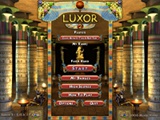
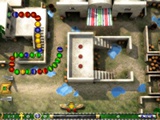
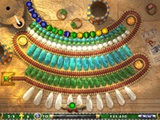
When starting Luxor 3, I instinctively looked at the playing
instructions first, and boy, does it get complicated. All the special effects
from the previous game are now linked to a colour and a favour from one of the
gods of Ancient Egypt, and consecutively popping three marble chains of the same
colour releases the related special effect. I don't know if it works exactly
like this in the game, because I don't keep count while frantically popping
marbles. As well as marbles, the player must pop canoptic jars - the special
jars with animal head lids that come in sets of four with each mummy - and
scarab beetles that appear and disappear at random in the playfield. Popping the
scarab beetles releases a few ankh coins, which, in this game, have an actual
purpose: to buy different-looking marble sets and paddles, or stronger special
effects. I visited the shop, but alas, as well as a relatively small amount of
ankh coins, each upgrade costs a huge amount of gameplay points.
The switch between the shop and normal play, or between levels, is marked by
a set of stone doors opening and closing. The scarab beetles are no longer cute
and bug-eyed as in the previous game, but red-eyed 3D renders with flapping
wings and stiff wiggly legs. There is a cursor above the marble chain indicating
where the paddle is aiming, and the playing speed seems normal again. There are
again three difficulty settings: easy, normal and difficult. There are also
three game modes: adventure, where you follow the story of the Pharaoh who, with
the help of the gods, must finish the pyramid after his death (yes, he would
need some divine help for that) while battling the evil god Seth, free play,
where you can replay every finished level, and puzzle, where you can redo all
puzzles.
Now you may say: "What do you mean, puzzle mode? And what happened to endless
mode?" The answer lies in a new introduction: extended game modes, which are
basically playing variations. The standard gameplay is called "classic mode"
(not to be confused with the three game modes above): destroy one or two marble
chains, catch falling valuables. A level using "classic mode" ends when all
marbles are gone. But the new playing styles, including one in the clouds where
chains of only two marbles have to be destroyed, but new chains keep popping up,
or another one in a hallway where a chain snakes down and obstacles appear in
front of it which shorten its path and so must be destroyed even more quickly
than the chain itself, are essentially endless, although they have a timer in
adventure mode. Each level has its own playing style, so to play in endless
mode, I just have to choose the "free play" game mode and start a level with one
of the new endless playing styles. Puzzle mode is a special case: this is a
playing style with no timer at all, where a marble chain has to be removed by
the calculated use of a limited number of marbles, and levels with this playing
style can only be replayed in the game mode that is also called puzzle mode.
Apparently the gamemakers wanted to forestall the boredom of just popping
marbles the usual way.
Much has been carried over from Luxor 3 into Luxor: Quest for
the afterlife: the canoptic jars, the ugly beetles, the ankh coins and shop to
buy upgrades (now arranged on a carpet instead of shelves), the aiming cursor
and last but not least, the quest to fix something from beyond the grave. This
time, the dead person who has to set something right before she can embark on a
happy afterlife is no less than Queen Nefertiti, who has to deal with tomb
robbers before she can rejoin her husband in spirit. This game shows how modern
it is by having not just a widescreen resolution, but voiceovers, and launches
into its story immediately after asking for the player's name, so I have to sit
out the blatherings in English with an Ancient Egyptian accent (as if there is
such a thing) before I can dive into the options screen to turn it off.
Unfortunately there is no separate setting to turn voice off, so I just set the
sound to zero and play without sound effects, which makes it much less fun.
There are differences, too: the sliding doors to mark scene changes are now a
splitting sun of Aten, the difficulty settings are now easy, medium, hard and
insane (which has to be unlocked), and while the special effects are no longer
connected with a god, I am expected to recover bits of artifact from each level
and rebuild these artifacts to catch the robbers. And there is a new extended
mode (ie. playing variation): battle mode, where the scarabs are working with
instead of against the player, and the player has to make new scarabs - this is
getting too complicated!
I believe this bundle is no longer available, having made way for the Luxor
9-in-1 bundle, which is not redeemable with monthly tokens.
Tradewinds Adventure Pack:
Tradewinds 2 was separately installed as an Acer GameZone demo, and is set in
the West Indies. I found it again as part of a 3-pack at CasualGames. The
location is the Middle East in Tradewinds Legends and moves right out to far
East Asia (the spice route) in Tradewinds Caravans. These games are obviously
from the same series as Tradewinds Odyssey. Are they as funny?
Let's find out.
I don't know what Tradewinds 1 looked like if it ever existed
(later discovery: it's called There are two ways to play: Story Mode, in which the character has to travel
from port to port and knock at each governor's door for quests (both port names
and governors' faces are randomized for each new game) while trading for profit
and better, bigger ships with more guns to defeat attacking pirates and liberate
ports, and occasionally meeting one of the other characters, ending in the
defeat of Sebastian LaRoche (or one of the "goodguys", if playing as LaRoche);
or Free Mode, which is just trading and improving the fleet, but where ports
spontaneously turn hostile if they haven't been visited in a while. As well as
buying ships (to a maximum of 10) with qualities like extra large hull, extra
strong hull or higher speed, it is possible to contract people met on quests,
like a passenger that makes the crew fight harder in sea battles, and buy items
like a compass that will avoid getting lost in a storm (and ending up at a
random port), or gimmicks for avoiding pirates and smuggling wares, but beware,
some items offered for sale are plain rubbish. Also, although money from
successful trades can be stored in banks, remember to always have enough on hand
to renew contracts and special items, because otherwise they will be gone, and
there is no way to get them back. The game is open-ended in both modes, but once
the fleet has been beefed up as far as possible, there's not much point in it.
Now, the humour factor: the intro stories for each character in Story Mode
are serious and a bit pompous, but comedy soon rears its head in the
Yarrrgh/Narrrgh buttons, Monty Python and other pop culture references, and
ridiculous quests that don't quite go as expected. So, yes, it is funny, though
not as uproariously so as Tradewinds Odyssey. And the same applies to the next
two games, which are the same principle applied to different locations with
prettier graphics.
Tradewinds Legends takes place in the area between North Africa
and the Far East, and so has radically different trading goods. This time, not
only the time of year but also the geographical location of the ports (which are
fixed this time) determine the price of the goods. There are four characters to
play, such as the wise old Tiger Bai or the Berber swordsman Hasan who seeks his
brother while avoiding the molestations of doting women, and one more character
which is unlocked by playing out at least one of the four storylines. There is
again a choice between Story Mode (collecting quests, which are almost identical
for each character, from each city ruler) or just trading (where, again,
ports/cities become spontaneously hostile after a time of absence) but, in
addition to the far prettier graphics and somewhat more pleasing background
music, this game has another twist on the previous one; although you start with
seafaring vessels, it becomes necessary, in order to reach the inland towns to
finish the last quests, to travel over land, and so, in time, the whole fleet
will consist of airships. Apart from that, although labels may differ, the
mechanics of the game are the same as in the previous game, complete with pop
culture references (including Orwell's 1984) and silly quests - like finding a
plumber after a famous group of belly dancers have clogged the palace drains
with their women's hygiene products.
If Tradewinds Legends switches between sea and air travel, in
Tradewinds Caravans, traders travel over land - on foot! Following the Silk
Route, they can be seen walking along the path the player sets them, over a
screen that scrolls to left and right, with their beasts of burden and armed
protectors, filling in the empty map as they cross it, running into wild beasts
and robbers, and finding bags of treasure if they search the surrounding
countryside well enough. Therefore, travel is not a matter of clicking on a
port/city on the map; each destination has to be located.
There are four roles to play, and two to unlock, one of them is - spoiler - a
dragon who has to rid himself of a curse. Dragons are one kind of beast the
player can encounter, undulating their way across the field. Again, there is a
quest and free trade mode - the quests are the most fantastic (in the sense of
fantasy) yet - and the game mechanics are the same basics even if in in a
completely different packet, the "fleet" now a troupe of up to ten beasts of
burden, the "cannons" armed escorts, and the special weapons depending on the
character chosen: the mother with the demonically possessed baby uses her baby's
now highly corrosive urine as an acid bomb. The graphics are also the prettiest
yet, the cities no longer two-dimensional presentations, but sprawling
collections of masonry, and all faces painted rather than drawn. The trade goods
are again topical, as is the oriental music with occasional whiny string
instrument.
Under the grandiosity of the storylines - deposed Persian princess must
reconquer hearts of people, mother of mysteriously ill children must find
disappeared husband, shrewd guide/advisor must survive the dimwitted Italian
merchant's son he serves - the comedy suffers a little, but there's still enough
witty dialogue left to crack some smiles.
Jolly Rover (demo)
Quite some time passed between redeeming this game and actually playing it. I
first found it at CasualGames and thought it was another sidescroller, like Supercow. But this was after CasualGames switched to
using the Games Manager instead of activation codes, and I stopped installing
games while thinking of a way around this (as I HATE the Games Manager). One
laptop and a registry-comparing utility later, I thought I'd install it anyway.
And it was gone! Disappeared off the site. I went to the customer support page
and it seems Oberon Media is completely a thing of the past, as I ended up on
www.iwin.com which is where all helpdesk issues are now handled, and had to
register with a new (and already forgotten) name/password to even make the
helpdesk ticket. Once I got to that stage, things went smoothly as the ticket
had a number of default choices which included "ask to get game token reimbursed
for game that's gone", which was very promptly done, and I quickly redeemed the
game token on a bundle that hopefully wouldn't suddenly disappear. But dangit, I
wanted to play that game! The sample screens had looked so pretty! Even Big Fish
Games didn't have it any more. Surfing for suitable casual games sites brought
up GameHouse, from where I installed a demo,
which nicely asked for a drive to install to and didn't add unwanted icons to
the Game Explorer. And so, the game has demo status again until I buy it either
from GameHouse, or on Amazon, because the game is sufficiently different from
the average casual game to be sold independently of the big casual-game outlets.
This is not a sidescroller at all, but a genuine adventure game, in the
spirit of (as other reviewers have stated before me) the
Monkey Island series; specifically the fourth adventure
which exchanged blocky pixel art for a drawn comic style. Its graphics are like
watching a Disney film. Sadly I can't add screenshots to show what I mean, as
screen capture doesn't work. As opposed to other games where screen capture
didn't work and produced a black rectangle, using the PrtSc key when this game
is running gets me a shot of the underlying desktop. The story goes: a beverage
is invented that combines alcohol with tobacco, making it extra addictive. It is
called "Jolly Rover", and a well-bred young lad called Gaius James Rover (a
dachshund with a long back, short bent legs and an aristocratically tapered
nose) is to transport a shipment of the stuff, when the ship is entered and
seized by pirates under captain Howley, a fearsome bulldog. The game starts with
James having to explain to Howley why he would make a good addition to the crew
in the multiple choice format I recognize from point-and-click adventure games.
There's plenty of arrr and yarrr in the game, both in its interface and in the
spoken text, all of which is subtitled, but the fun is in the listening: this
may be the only game ever where I've enjoyed the voice acting. Anyway, James is
locked in the brig instead, and has to find a way out. In the hold, he becomes
acquainted with the hint system, a parrot who insists on being called by his
full name of Juan Leon, and who will impart cryptic information, and additional
information for crackers (which can be found at various points in the game -
search carefully). The hint system is not perfect, for instance, it doesn't tell
me how to grind the peppercorns. There is a second kind of hint system: press
the Space bar, and all interactive areas are highlighted; easy for when I've
missed a spot.
Having called it a genuine adventure game, its point-and-click interface is
very rudimentary: it really is just point and click, or grab item from inventory
and hold it over something else and click, there are no "look" or "walk" or "use
x on y" buttons. The idea is to move the cursor all over the screen and click on
anything that has blue text hovering over it; most of it is useless, but all of
it is good for a snarky comment.
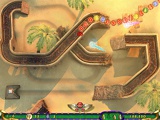
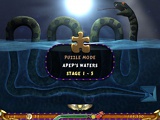
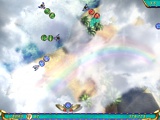
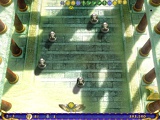
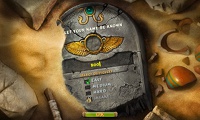
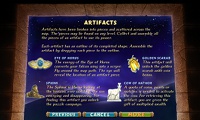
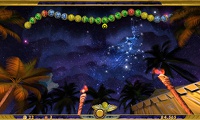
Tradewinds 2
Tradewinds Legends
Tradewinds Caravans
